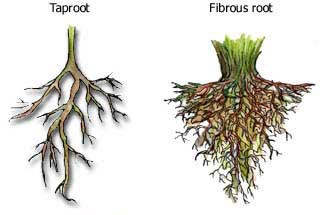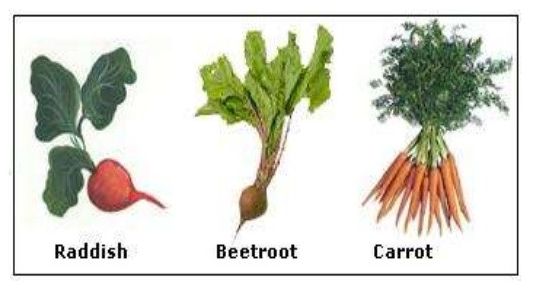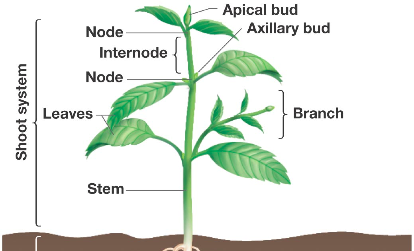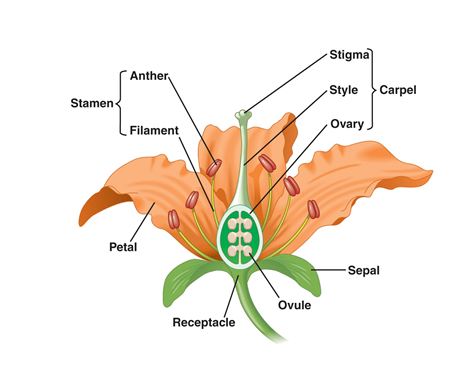Morphology of Flowering Plants
Table of Content |
 Morphology is the branch of science which deals with the study of external structural of the plants.
Morphology is the branch of science which deals with the study of external structural of the plants.
The flowering plant consists of An Axis, Root System and Shoot System.
Root System
The flowering plants consist of a long cylindrical axis which is differentiated into an underground Root System.
 Root is the descending, non green, underground part lacking nodes, internodes, leaves and buds.
Root is the descending, non green, underground part lacking nodes, internodes, leaves and buds.
In Dicotyledon plants, the elongation of radicle leads to the formation of primary root. The primary root grows inside the soil. Primary root bears lateral roots known as Secondary Roots, Tertiary Roots etc.
Types of Root System
The primary roots along with its branches forms a Tap Root system. For Example: Mustard Plant. Primary roots have short life span and are replaced by large roots later on.
The roots which arises from the base of the stem are known as Fibrous Root system. For Example: Grasses. This type of system is common in Mocotyledon Plants.The roots which arises from the part other than the radicle are known as Adventitious Roots. For Example: Banyan Tree, Monstera.
Regions of the Root
The root has five main regions which are as follows:
-
 Root Cap is the structure that covers the apex/tip of the root. It helps in protecting the apex of the root.
Root Cap is the structure that covers the apex/tip of the root. It helps in protecting the apex of the root. -
Region of Meristematic Activity located few millimeters above the root cap. The cells of this region has the property of repeated divisions which is needed for the growth of the plant.
-
Region of Elongation is located proximal to the region of meristematic activity. This is required for the elongation of root.
-
Region of Maturation is located proximal to region of elongation. These cells gradually differentiate and mature.
-
Root Hairs arise from the region of maturation which helps in absorption of water and minerals from the soil.
Modifications of the Root
Roots modify in structure to perform different functions as explained below:
-
Fusiform root is a modified form of tap root. The root is swollen from the middle and tapers at both the ends. For Example: Radish
-
Napiform roots are also a modified tap root. They have swollen base and then it tapers abruptly. For Example: Turnip
-
Prop roots are roots which are modified for aerial support. For Example: Corn
-
Stilt roots are modified roots for support. For Example: Maize
-
Pneumatophores are roots modified for respiration. They grow in swampy area and grow vertically upwards. For Example: Rhizophora
Functions of the Root
-
To absorb water and minerals from the soil.
-
To provide proper anchorage to the plants.
-
To store reserve food materials
-
Synthesis of plant growth regulators
Shoot System
It is an aerial system, usually above the soil and originates from the plumule. It consists of stem, branches, leaves, flowers and fruits.
Stem
It facilitates conduction of water, mineral and food material. The flowers, fruits and seeds form the reproductive parts of the plants. The stem bears the nodes and internodes. The point from where the leaf arises is known as Node and the part between the two Nodes are known as Internodes.
Modification of Stems
Similar to roots, the stem is also modified to perform different functions:
-
Tendrils are slender, twining strands that allow the plant to climb and helps in support. For Example: Cucumber.
-
Thorns are modified stem for protection of the plant. They are hard, woody and sharp outgrowths from the plant. For Example: Rose.
Fig.6. Modifications of Stem
-
Cladodes are modified stem that perform the function of photosynthesis.
-
Bulbils are modified stem that becomes fleshy and store food.
Leaf
Leaf is a green dorsoventrally flattened exogenous lateral outgrowth that arises from a node of the stem or a branch. The leaf is a specialized organ of photosynthesis, transpiration and gaseous exchange.
 Parts of Leaf
Parts of Leaf
The point of origin of leaf is known as Node. It bears bud in its axil. The leaf is attached to the stem by the leaf base and have two lateral leaf like structures called Stipules. In monocots, the leaf base is swollen to form pulvinus. The stalk of the leaf is known as Petiole. The green exposed part of the leaf is known as lamina. Lamina bears the veins or veinlets. The arrangement of veins on the leaf is known as Venation.
There are basically two types of Venation: Parallel Venation and Reticulate Venation.
Parallel venation is observed when veins run parallel to each other. For Example: Monocots
Reticulate venation is observed when veinlets form network. For Example: Dicots
Fig.8. Types of Venation
Flower
The modified shoot is known as Flower. The arrangement of flower on the floral axis is known as Inflorescence.
There are two major types of Inflorescence- Racemose and Cymose.
In racemose type of inflorescence, new flowers are generated at the tip of the inflorescence. For Example: Snapdragon
In cymose type of inflorescence, new flowers are generated at the base of the inflorescence.
Structure of the Flower
Each flower has four whorls- Sepals, Petals, Stamens and the Carpels. Sepals are green leafy structures that covers the flower bud. Petals are bright colored to attract insects for pollination.
Gynoecium are female reproductive structures whereas Androecium is the male reproductive structure.
Fig.5. Structure of the Flower
Gynoecium is composed of carpels. Carpels comprises of three structures: Ovary, Style and Stigma. Ovary comprises of ovules that forms the seed, whereas stigma is the place of landing of pollen at the time of pollination. Ovary finally forms the fruit.
The male part of the flower is known as Androecium. Androecium is composed of stamens. Stamen is composed of anther and the filament. Anthers contain the pollen grains, the male gamete.
Watch this Video for more reference
To read more, Buy study materials of Morphology of Flowering Plants comprising study notes, revision notes, video lectures, previous year solved questions etc. Also browse for more study materials on Biology here.
View courses by askIITians


Design classes One-on-One in your own way with Top IITians/Medical Professionals
Click Here Know More

Complete Self Study Package designed by Industry Leading Experts
Click Here Know More

Live 1-1 coding classes to unleash the Creator in your Child
Click Here Know More

a Complete All-in-One Study package Fully Loaded inside a Tablet!
Click Here Know MoreAsk a Doubt
Get your questions answered by the expert for free






